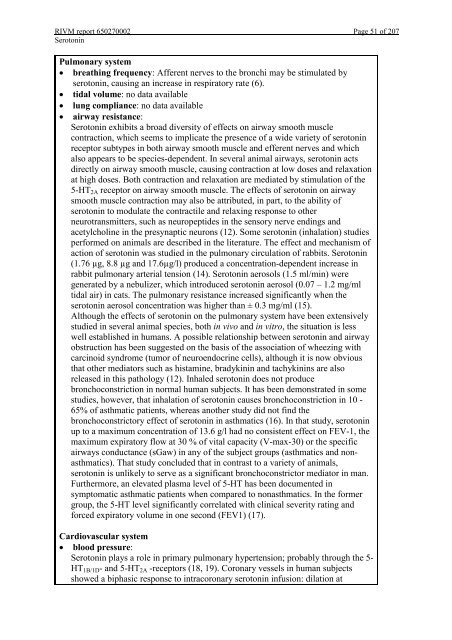The Contribution of cocoa additive to cigarette smoking addiction
The Contribution of cocoa additive to cigarette smoking addiction
The Contribution of cocoa additive to cigarette smoking addiction
You also want an ePaper? Increase the reach of your titles
YUMPU automatically turns print PDFs into web optimized ePapers that Google loves.
RIVM report 650270002 Page 51 <strong>of</strong> 207<br />
Sero<strong>to</strong>nin<br />
Pulmonary system<br />
breathing frequency: Afferent nerves <strong>to</strong> the bronchi may be stimulated by<br />
sero<strong>to</strong>nin, causing an increase in respira<strong>to</strong>ry rate (6).<br />
tidal volume: no data available<br />
lung compliance: no data available<br />
airway resistance:<br />
Sero<strong>to</strong>nin exhibits a broad diversity <strong>of</strong> effects on airway smooth muscle<br />
contraction, which seems <strong>to</strong> implicate the presence <strong>of</strong> a wide variety <strong>of</strong> sero<strong>to</strong>nin<br />
recep<strong>to</strong>r subtypes in both airway smooth muscle and efferent nerves and which<br />
also appears <strong>to</strong> be species-dependent. In several animal airways, sero<strong>to</strong>nin acts<br />
directly on airway smooth muscle, causing contraction at low doses and relaxation<br />
at high doses. Both contraction and relaxation are mediated by stimulation <strong>of</strong> the<br />
5-HT2A recep<strong>to</strong>r on airway smooth muscle. <strong>The</strong> effects <strong>of</strong> sero<strong>to</strong>nin on airway<br />
smooth muscle contraction may also be attributed, in part, <strong>to</strong> the ability <strong>of</strong><br />
sero<strong>to</strong>nin <strong>to</strong> modulate the contractile and relaxing response <strong>to</strong> other<br />
neurotransmitters, such as neuropeptides in the sensory nerve endings and<br />
acetylcholine in the presynaptic neurons (12). Some sero<strong>to</strong>nin (inhalation) studies<br />
performed on animals are described in the literature. <strong>The</strong> effect and mechanism <strong>of</strong><br />
action <strong>of</strong> sero<strong>to</strong>nin was studied in the pulmonary circulation <strong>of</strong> rabbits. Sero<strong>to</strong>nin<br />
(1.76 µg, 8.8 µg and 17.6µg/l) produced a concentration-dependent increase in<br />
rabbit pulmonary arterial tension (14). Sero<strong>to</strong>nin aerosols (1.5 ml/min) were<br />
generated by a nebulizer, which introduced sero<strong>to</strong>nin aerosol (0.07 – 1.2 mg/ml<br />
tidal air) in cats. <strong>The</strong> pulmonary resistance increased significantly when the<br />
sero<strong>to</strong>nin aerosol concentration was higher than ± 0.3 mg/ml (15).<br />
Although the effects <strong>of</strong> sero<strong>to</strong>nin on the pulmonary system have been extensively<br />
studied in several animal species, both in vivo and in vitro, the situation is less<br />
well established in humans. A possible relationship between sero<strong>to</strong>nin and airway<br />
obstruction has been suggested on the basis <strong>of</strong> the association <strong>of</strong> wheezing with<br />
carcinoid syndrome (tumor <strong>of</strong> neuroendocrine cells), although it is now obvious<br />
that other media<strong>to</strong>rs such as histamine, bradykinin and tachykinins are also<br />
released in this pathology (12). Inhaled sero<strong>to</strong>nin does not produce<br />
bronchoconstriction in normal human subjects. It has been demonstrated in some<br />
studies, however, that inhalation <strong>of</strong> sero<strong>to</strong>nin causes bronchoconstriction in 10 -<br />
65% <strong>of</strong> asthmatic patients, whereas another study did not find the<br />
bronchoconstric<strong>to</strong>ry effect <strong>of</strong> sero<strong>to</strong>nin in asthmatics (16). In that study, sero<strong>to</strong>nin<br />
up <strong>to</strong> a maximum concentration <strong>of</strong> 13.6 g/l had no consistent effect on FEV-1, the<br />
maximum expira<strong>to</strong>ry flow at 30 % <strong>of</strong> vital capacity (V-max-30) or the specific<br />
airways conductance (sGaw) in any <strong>of</strong> the subject groups (asthmatics and nonasthmatics).<br />
That study concluded that in contrast <strong>to</strong> a variety <strong>of</strong> animals,<br />
sero<strong>to</strong>nin is unlikely <strong>to</strong> serve as a significant bronchoconstric<strong>to</strong>r media<strong>to</strong>r in man.<br />
Furthermore, an elevated plasma level <strong>of</strong> 5-HT has been documented in<br />
symp<strong>to</strong>matic asthmatic patients when compared <strong>to</strong> nonasthmatics. In the former<br />
group, the 5-HT level significantly correlated with clinical severity rating and<br />
forced expira<strong>to</strong>ry volume in one second (FEV1) (17).<br />
Cardiovascular system<br />
blood pressure:<br />
Sero<strong>to</strong>nin plays a role in primary pulmonary hypertension; probably through the 5-<br />
HT1B/1D- and 5-HT2A -recep<strong>to</strong>rs (18, 19). Coronary vessels in human subjects<br />
showed a biphasic response <strong>to</strong> intracoronary sero<strong>to</strong>nin infusion: dilation at
















